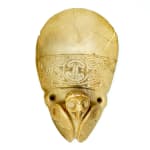Taíno Ceremonial Celt, depicting a Bird , AD 1200 - AD 1500
Greenstone
29 x 19 x 10 cm
11 3/8 x 7 1/2 x 4 in
11 3/8 x 7 1/2 x 4 in
LI.1999
Further images
When Europeans arrived in the New World, the Taíno were the principal inhabitants of the Caribbean islands of Cuba, Hispaniola, Jamaica, Puerto Rico, the Bahamas, and the Lesser Antilles. The...
When Europeans arrived in the New World, the Taíno were the principal inhabitants of the Caribbean islands of Cuba, Hispaniola, Jamaica, Puerto Rico, the Bahamas, and the Lesser Antilles. The Lucayan branch of the Taíno were the first people encountered by the Columbus expedition in AD 1492. They were an ancient people, who probably emigrated to the islands from South and Central America, though the Taíno origin story retells that they emerged from caves on the island of Hispaniola at the dawn of time. The Taíno were ruled by male chiefs, called caciques, who inherited their position through matrilineal succession. Below them were nobles (nitaínos) and commoners (naborias). Taíno women engaged in agriculture, while the men fished and hunted. They developed the use of poisoned arrowheads for hunting.
Celts, or teardrop-shaped axeheads, were a common tool among the Taíno. But they could also have a ritual or ceremonial use. Oversized celts, attached to a wooden handle, formed a ceremonial hatchet called a manaya, which served as a symbol of the power of the cacique. While many ceremonial celts are undecorated, this greenstone example has a figure of a bird at the bottom, with large vacant round eyes, a stylised beak, and a pair of wings held down by its side with geometric patterns. In many Taíno images, the birds are mixed with human characteristics, as in this example; in this case, the birds are considered a masculine symbol. It is possible that the bird represented is an owl, given the wide round eyes enclosed in an incised ring. Across the centre of the ‘blade’ is another band of geometric patterning. There are two holes in the piece for attaching it to a wooden handle.
Different types of birds are important to the Taíno. Aquatic birds were especially significant, given that they bridge water, land and sky. They were associated with the water zemí Coatrisquie; she was the destructive force of water, which flowed through streams to destroy the countryside. Similarly, night birds were associated with the forest spirits (opias). Owls were especially venerated, given their association with the caves deep in the forest. Their sharp eyesight, that can see in the blackness of the night, was thought to enable them to see into the spirit realm.
Celts, or teardrop-shaped axeheads, were a common tool among the Taíno. But they could also have a ritual or ceremonial use. Oversized celts, attached to a wooden handle, formed a ceremonial hatchet called a manaya, which served as a symbol of the power of the cacique. While many ceremonial celts are undecorated, this greenstone example has a figure of a bird at the bottom, with large vacant round eyes, a stylised beak, and a pair of wings held down by its side with geometric patterns. In many Taíno images, the birds are mixed with human characteristics, as in this example; in this case, the birds are considered a masculine symbol. It is possible that the bird represented is an owl, given the wide round eyes enclosed in an incised ring. Across the centre of the ‘blade’ is another band of geometric patterning. There are two holes in the piece for attaching it to a wooden handle.
Different types of birds are important to the Taíno. Aquatic birds were especially significant, given that they bridge water, land and sky. They were associated with the water zemí Coatrisquie; she was the destructive force of water, which flowed through streams to destroy the countryside. Similarly, night birds were associated with the forest spirits (opias). Owls were especially venerated, given their association with the caves deep in the forest. Their sharp eyesight, that can see in the blackness of the night, was thought to enable them to see into the spirit realm.













